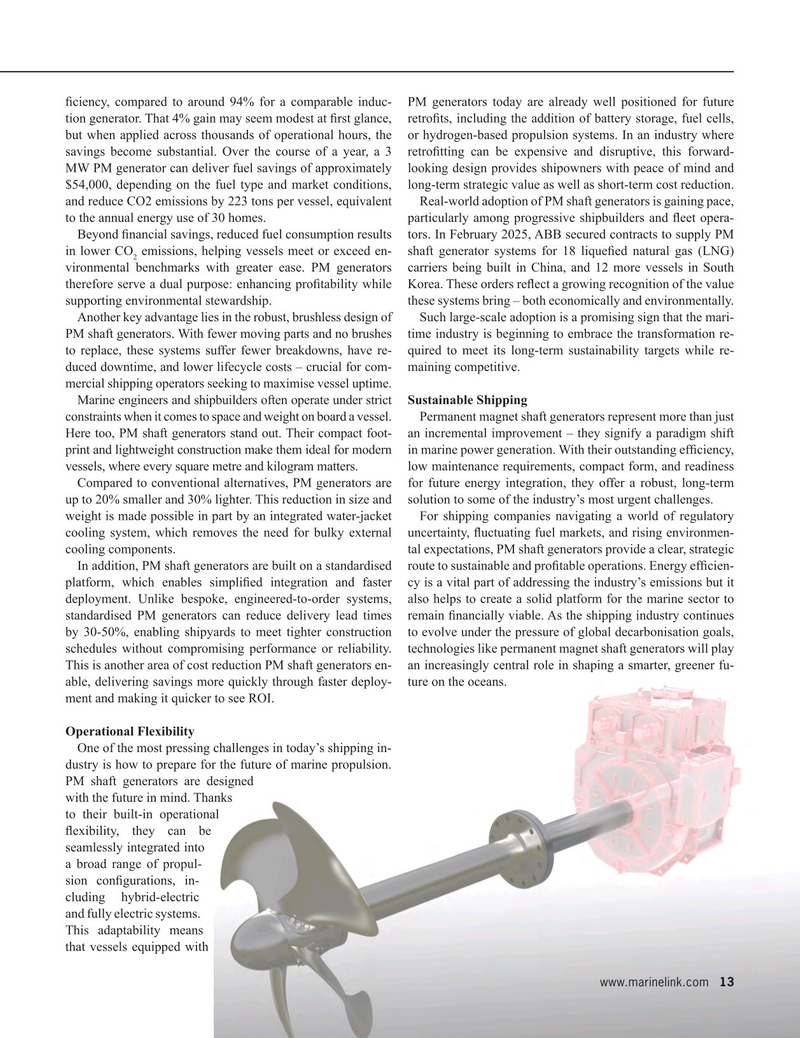
Page 13: of Maritime Reporter Magazine (June 2025)
Read this page in Pdf, Flash or Html5 edition of June 2025 Maritime Reporter Magazine
? ciency, compared to around 94% for a comparable induc- PM generators today are already well positioned for future tion generator. That 4% gain may seem modest at ? rst glance, retro? ts, including the addition of battery storage, fuel cells, but when applied across thousands of operational hours, the or hydrogen-based propulsion systems. In an industry where savings become substantial. Over the course of a year, a 3 retro? tting can be expensive and disruptive, this forward-
MW PM generator can deliver fuel savings of approximately looking design provides shipowners with peace of mind and $54,000, depending on the fuel type and market conditions, long-term strategic value as well as short-term cost reduction.
and reduce CO2 emissions by 223 tons per vessel, equivalent Real-world adoption of PM shaft generators is gaining pace, to the annual energy use of 30 homes. particularly among progressive shipbuilders and ? eet opera-
Beyond ? nancial savings, reduced fuel consumption results tors. In February 2025, ABB secured contracts to supply PM in lower CO emissions, helping vessels meet or exceed en- shaft generator systems for 18 lique? ed natural gas (LNG) 2 vironmental benchmarks with greater ease. PM generators carriers being built in China, and 12 more vessels in South therefore serve a dual purpose: enhancing pro? tability while Korea. These orders re? ect a growing recognition of the value supporting environmental stewardship. these systems bring – both economically and environmentally.
Another key advantage lies in the robust, brushless design of Such large-scale adoption is a promising sign that the mari-
PM shaft generators. With fewer moving parts and no brushes time industry is beginning to embrace the transformation re- to replace, these systems suffer fewer breakdowns, have re- quired to meet its long-term sustainability targets while re- duced downtime, and lower lifecycle costs – crucial for com- maining competitive.
mercial shipping operators seeking to maximise vessel uptime.
Marine engineers and shipbuilders often operate under strict Sustainable Shipping constraints when it comes to space and weight on board a vessel. Permanent magnet shaft generators represent more than just
Here too, PM shaft generators stand out. Their compact foot- an incremental improvement – they signify a paradigm shift print and lightweight construction make them ideal for modern in marine power generation. With their outstanding ef? ciency, vessels, where every square metre and kilogram matters. low maintenance requirements, compact form, and readiness
Compared to conventional alternatives, PM generators are for future energy integration, they offer a robust, long-term up to 20% smaller and 30% lighter. This reduction in size and solution to some of the industry’s most urgent challenges.
weight is made possible in part by an integrated water-jacket For shipping companies navigating a world of regulatory cooling system, which removes the need for bulky external uncertainty, ? uctuating fuel markets, and rising environmen- cooling components. tal expectations, PM shaft generators provide a clear, strategic
In addition, PM shaft generators are built on a standardised route to sustainable and pro? table operations. Energy ef? cien- platform, which enables simpli? ed integration and faster cy is a vital part of addressing the industry’s emissions but it deployment. Unlike bespoke, engineered-to-order systems, also helps to create a solid platform for the marine sector to standardised PM generators can reduce delivery lead times remain ? nancially viable. As the shipping industry continues by 30-50%, enabling shipyards to meet tighter construction to evolve under the pressure of global decarbonisation goals, schedules without compromising performance or reliability. technologies like permanent magnet shaft generators will play
This is another area of cost reduction PM shaft generators en- an increasingly central role in shaping a smarter, greener fu- able, delivering savings more quickly through faster deploy- ture on the oceans.
ment and making it quicker to see ROI.
Operational Flexibility
One of the most pressing challenges in today’s shipping in- dustry is how to prepare for the future of marine propulsion.
PM shaft generators are designed with the future in mind. Thanks to their built-in operational ? exibility, they can be seamlessly integrated into a broad range of propul- sion con? gurations, in- cluding hybrid-electric and fully electric systems.
This adaptability means that vessels equipped with www.marinelink.com 13
MR #6 (1-17).indd 13 MR #6 (1-17).indd 13 5/31/2025 8:34:15 PM5/31/2025 8:34:15 PM

 12
12

 14
14
